June, 2019
I began a new journey in May of 2016, aiming to climb every one of the 48 mountains in New Hampshire that are at least 4000 feet tall, and to write a description of each ascent. And, each time, I wanted to write a reflection, sequentially, on my journey since joining Peace Corps just over 35 years ago: on development, social justice, conflict, experiences along the way, etc.
Last time I shared a few reflections that seemed to cut across these articles, a handful of themes that emerged for me as I prepared the previous 46 blogs. I hope you enjoyed it…
This is the 48th, and final article in the “4000-footer” series. It seems fitting to take time now to thank some of the many people who have helped me along the way.
To skip the description of my ascent of Mt Jefferson, and go directly to my thanks to those amazing people, click here.
The Climb – Mt Jefferson
I left Durham at 6:50am on June 22, 2018, on a beautiful, crisp, clear cool day. My plan was to walk up the Castle Ravine Trail to the top of Jefferson, and then drop down the Castle Trail. I had read about both trails, and noted the warning that it was better to ascend Castle Ravine, on the Castle Ravine Trail, due to the steep and rocky section near the top; this would be much easier to ascend than to descend. Then, descend the Castle Trail.
And so it was!
After stopping for coffee in Ossipee, and a sandwich in Gorham, I began the hike from a parking area just off Rt 2 in Bowman, New Hampshire, at 9:38am. So it was over 2 1/2 hours from Durham. The views of Mt Madison and Mt Adams, which I had climbed the week before, were spectacular as I passed through Pinkham Notch on the way north.
The sky was cloudless, and the temperature was perfect. Perfect conditions for my final ascent of these 48 mountains!

I parked at Bowman.

The beginning of the walk is along a Rail-Trail, but the path soon takes a left turn onto the Castle Trail:
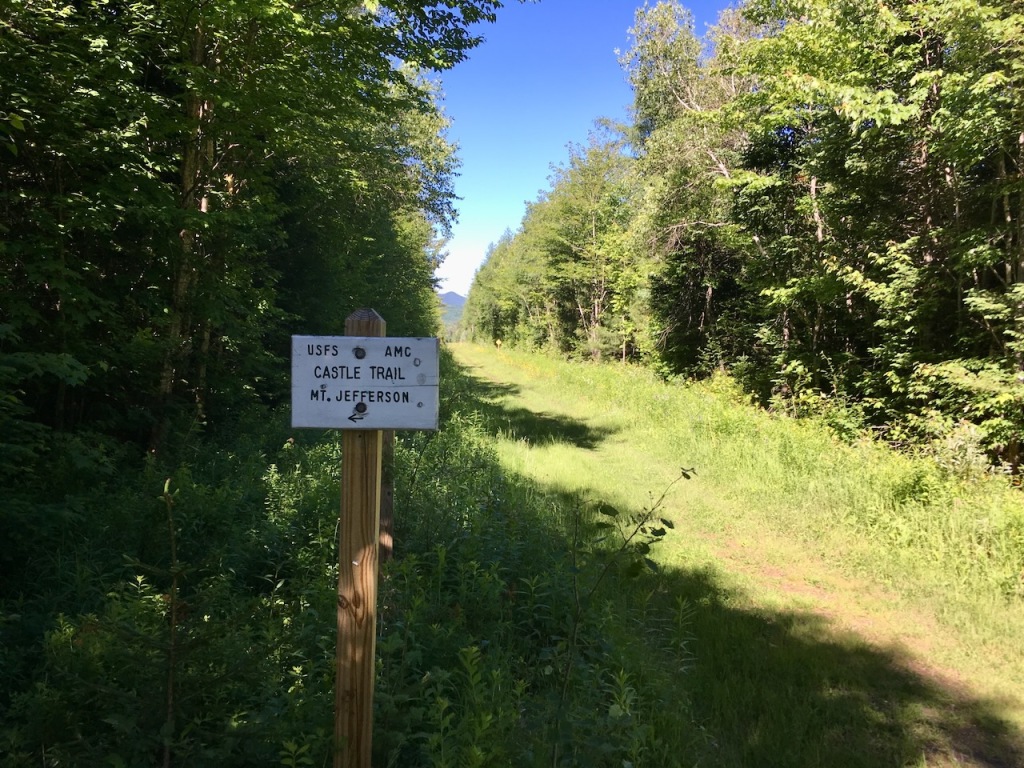
This sign grabbed my attention, as it had been designed to do!
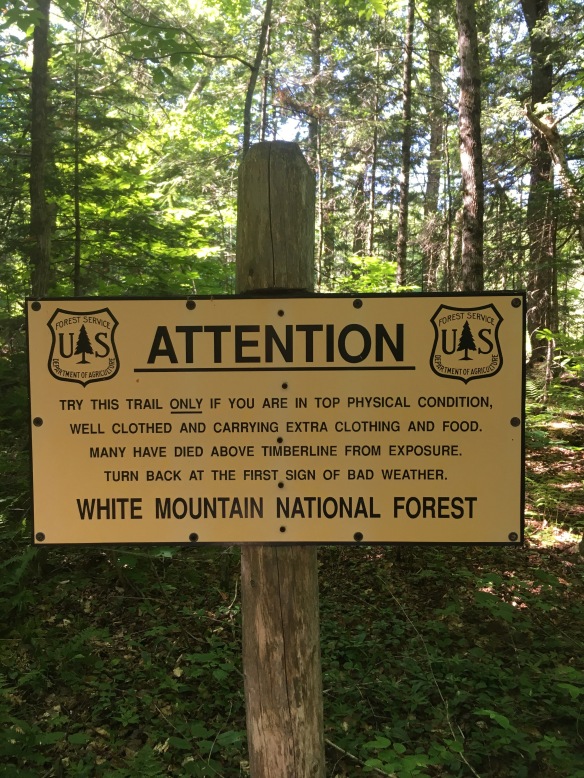
There would be two more signs like this. I wasn’t sure that I was in “top physical condition,” but I was going to give it a try!
Now the trail entered typical White-Mountain forest, and soon after entering the forest there was my first stream crossing. Nothing difficult, but I did manage to fall into the water. Luckily, the water didn’t reach my ankles, so my feet stayed dry!
From there I ascended gently up the Castle Trail until reaching the junction with the Israel Ridge Path at a bit after 10am:
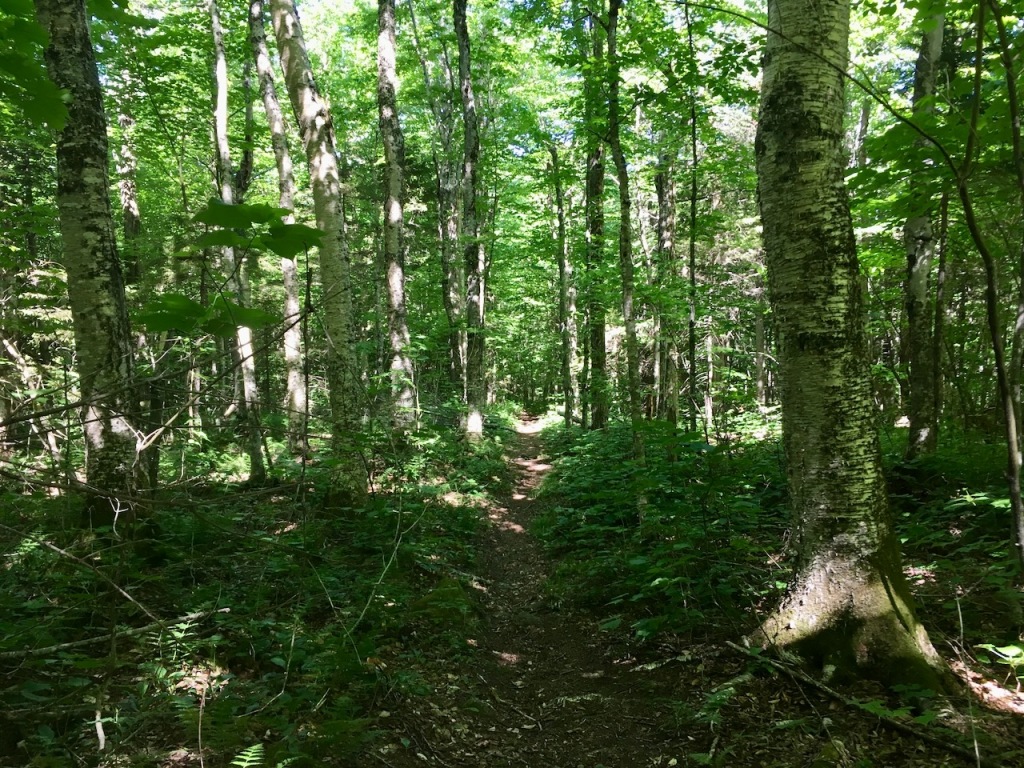



Here I took the left fork, and continued steadily up the Israel Ridge Path for 15 minutes, making the first of what would be 5 or 6 more stream crossings before taking the right-hand fork onto the Castle Ravine Trail:
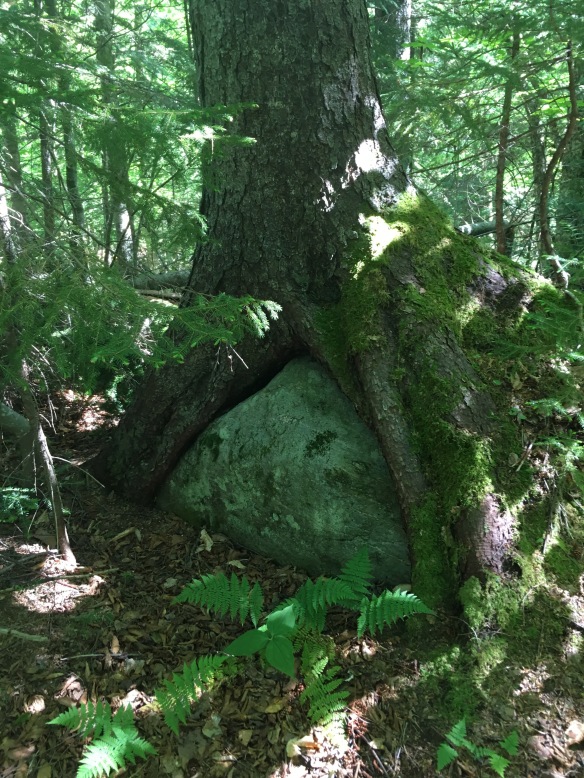

At 10:25am I reached the junction of the Israel Ridge Path and the Castle Ravine Trail. Here I took a right-hand turn, and began the long walk up the ravine, crossing the Castle Brook several times:
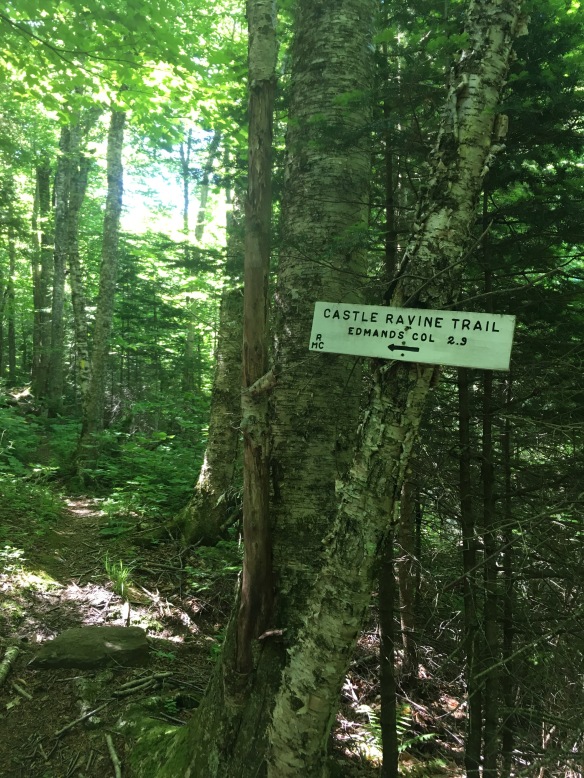


At 11:20am, I reached the junction with The Link Trail, which joined Castle Ravine from the left. The trail was getting steeper:
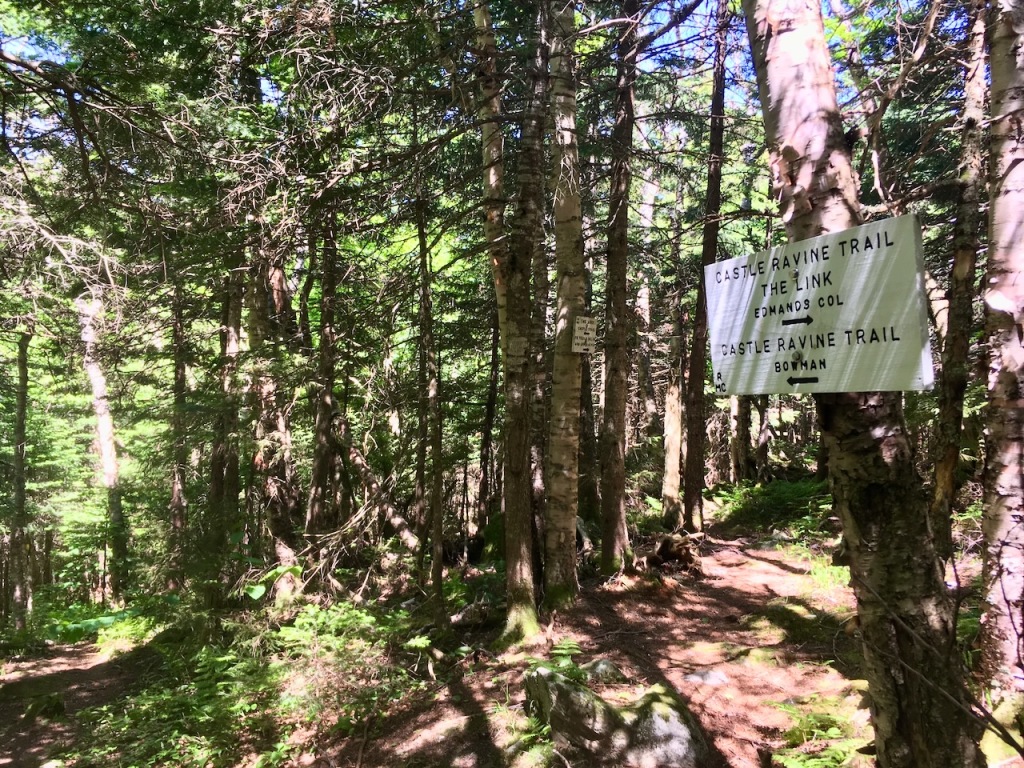
Just 8 minutes later I arrived at the junction of the Emerald Trail and, a few moments after that, the Link Trail diverged to the right:
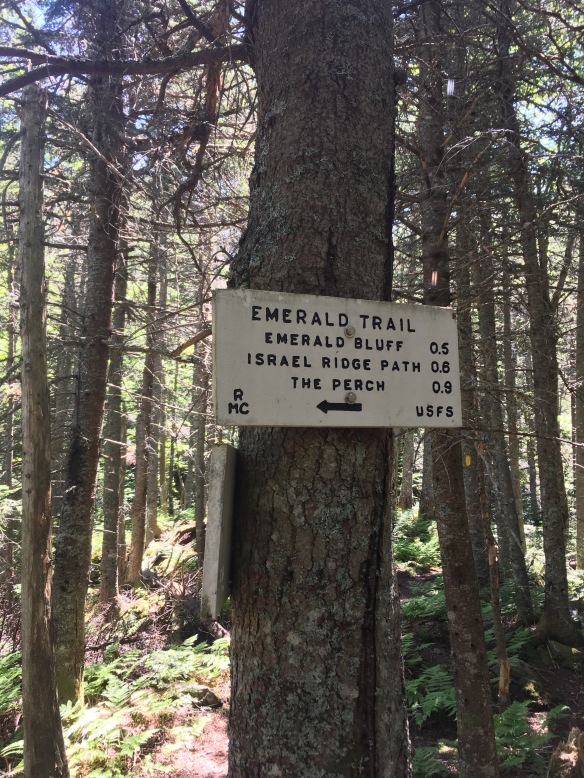
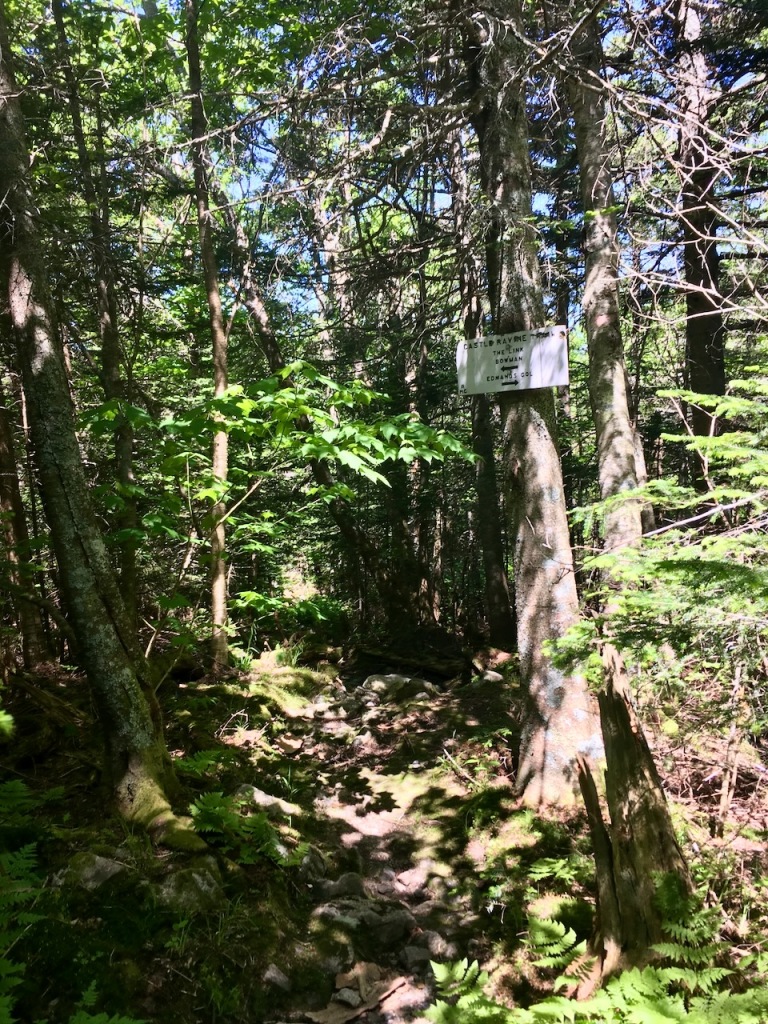


I was walking up Castle Ravine, the sides of which were closing in on me! It felt like the pleasant, moderately-steep forest walking was going to come to an end soon, as I reached the end of the ravine!
At 11:45am I emerged into an avalanche area (from 2010, according to the White Mountain Guide), where I could see up to the ridge above me. Lovely blue sky; a few hours later I would look down from those boulders as I descended on the Castle Trail:
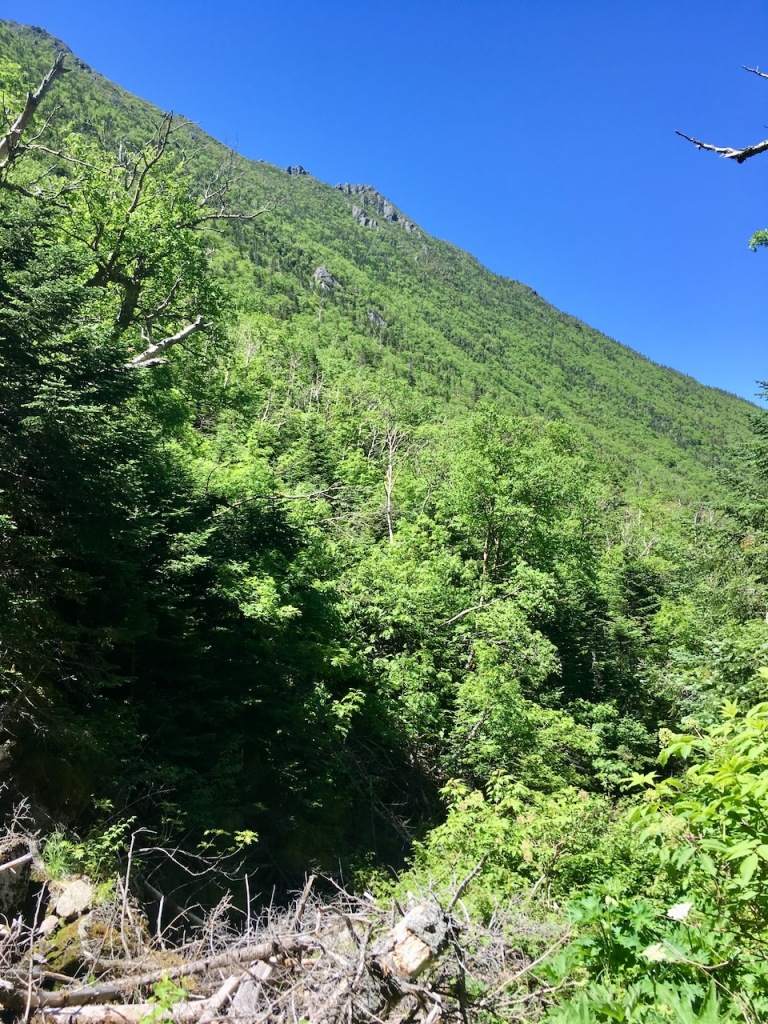
Just ten minutes later I came across a famous feature of the Castle Ravine Trail – this short “tunnel” where the path goes underneath an enormous boulder. Literally underneath!

As I took that photo, I saw two legs appear at the other end, and a stream of swearing erupted. The hiker on the other side hadn’t seen me, and (it turned out) had twisted his ankle and was frustrated. When he saw me he was very apologetic!
The hiker was doing a reverse of what I had planned – going up Castle Trail, and down Castle Ravine. He was walking with a nice black labrador dog, and part of his frustration was that they had just descended a large talus field, which had been very tricky for the dog. Very few level areas, which made it hard for the dog to make its way through, so the owner had to carry it for much of the descent, which must have been very difficult. As I would soon see, the rock field is very steep – the White Mountain Guide had strongly recommended ascending this way, and descending on Castle Trail, just to avoid going down those rocks. Hard enough for a person, virtually impossible for a dog, I reckon!
“… parts of the trail are very rough especially where it crosses a great deal of unstable talus on the headwall, which makes footing extremely poor for descending or when the rocks are wet.”
Here’s what that talus looked like, when I was near the end of it nearly two hours later:

Clearly very challenging for a dog! They had taken a long time to drop down that section of the trail, and the owner had carried the dog for much of the way. Plus, the hiker was wearing walking shoes, not boots, which explained why he had twisted his ankle (apparently several times on the way down.)
Underneath the boulder I came across my first ice of the hike – protected from the sun and buffered from the heat of the day, this ice was still here on the day after the summer solstice!

Just after noon I emerged into the alpine area, where I came across the second warning sign – here a bit more explicit than the sign near the parking area had been!

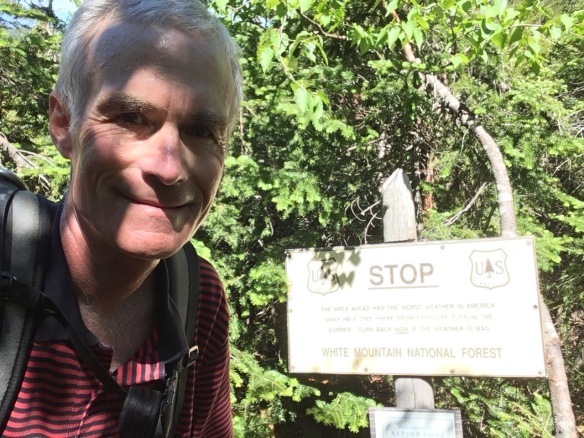
Here I continued to walk up very steeply on loose rock. Must have been very hard for the dog! I took a wrong turn at one point, ascending steeply, and had to drop back down where I found the trail. So I lost some time and energy there!
Spectacular views to the north here, looking down the ravine, the way I had come:


Here are two images of the trail I was walking slowly up:

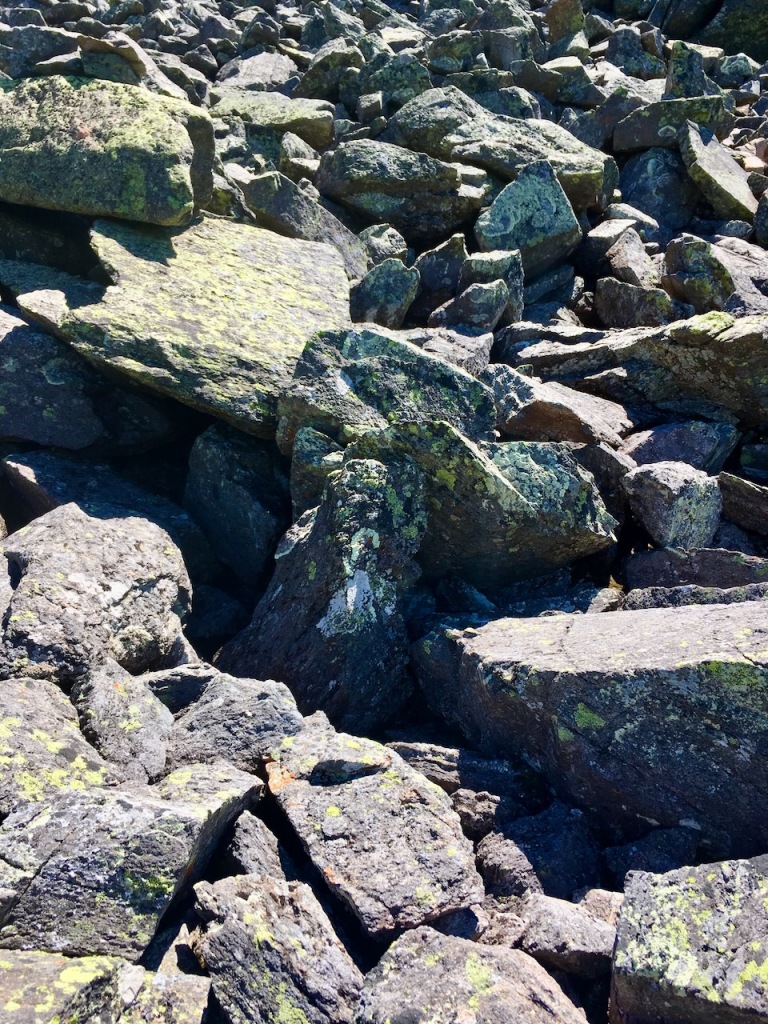
At 1:15pm, the trail began to level off and I filmed a video of the view to the north:
I had reached a much flatter area here, which was a great relief after a long stretch slogging up the steep talus. Five minutes later I reached the junction with the Cornice trail and the Randolph Path:

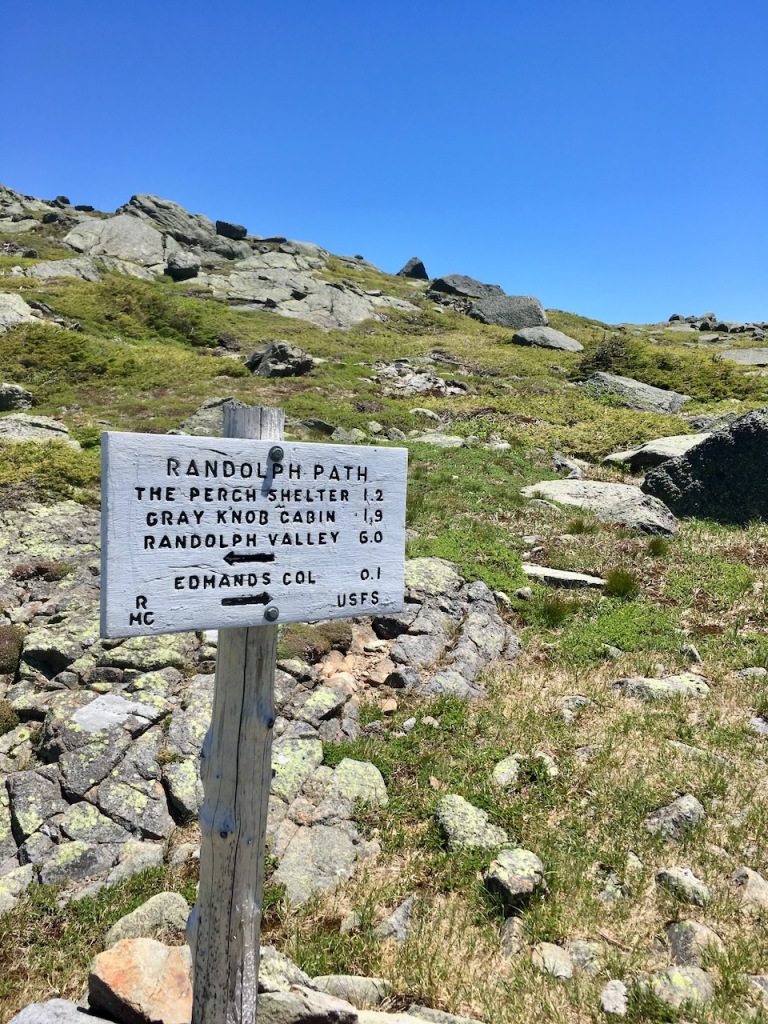
And then I was at Edmund’s Col, a saddle between Adams and Jefferson. Now I had a spectacular view to the south and south-east, including Adams and looking to the east across Rt 16 and Pinkham Notch overt to the Carter and Wildcat ranges. This panoramic video captures the scene from where I had lunch:
A gorgeous day! I was well above tree-line, in one of the world’s most beautiful alpine areas.
After lunch, I continued towards Mt Jefferson. I took this photo as I began to climb, back towards Mt Adams; you can see Mt Adams at the top right, with Mt Sam Adams to the left, and the trail (the Gulfside Trail) clearly visible below. I had eaten lunch at the saddle in the foreground:

As I climbed, at 1:55pm, I came to a snow field! Believe it or not, there was still a small patch of snow left to walk across, on this, the day after the summer solstice! Hard to believe:

I had seen this patch of snow from Mt Adams the week before. Soon I arrived at the junction of the Loop Trail and took a right turn to get to the top of Jefferson. At 2:15pm I reached the junction of Loop Trail and Six Husbands Trail:

And at 2:25pm I reached the top of Mt Jefferson! So I had completed climbing all 48 of New Hampshire’s 4000-footers – just two years and two months after I had started by ascending Mt Tom:

It felt great to have completed climbing all 48 of New Hampshire’s 4000-footers. I spent a bit of time thinking about the journey over the last two years and two months. A great accomplishment, and a good way of using the time that I had after returning from Australia.
Now what?!
It was quite buggy at the top of Mt Jefferson, as can be seen in these videos. But it was also spectacular, with views all the way around:
I put on some Bushman insect repellent and began to descend on the Castle Trail.


At 3:10pm I arrived at the junction of Castle Trail and The Cornice, and continued downward. The walking was difficult, a lot of talus, but not nearly as steep as the Castle Ravine Trail:

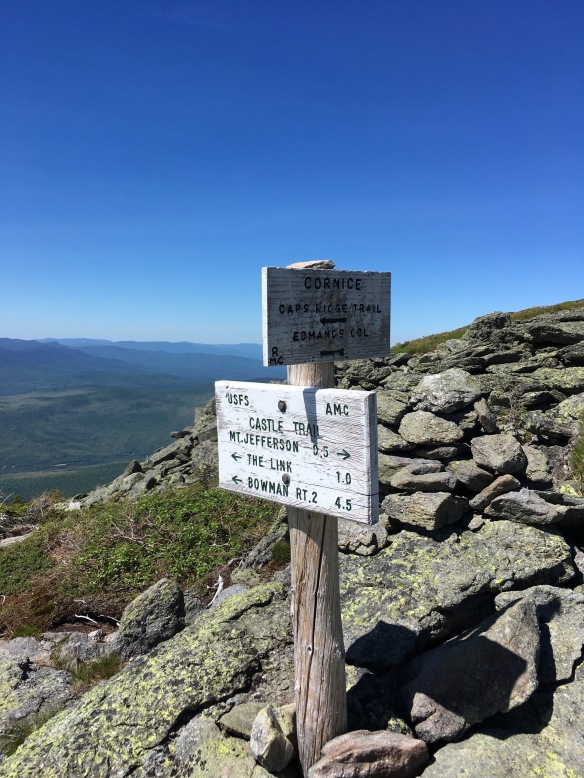
Now I started to get great views down towards the Castle Ravine, which I had climbed up that morning:

This video shows the full length of the Castle Ravine, with Mt Adams to the north, and Rt 2 down below:
At this point I left the alpine zone, with the third warning sign:

There was only one other person on this part of the Castle Trail, a middle-aged French Canadian who was going to take the Link Trail. He had apparently climbed Jefferson and Adams that day, and wanted to avoid climbing Jefferson a second time!
I arrived at the junction of the Link Trail, where he took a left, at around 4:15pm.

Here the trail became more forested, small pines and ferns at first. The going was very steep for some time, and my knees started to feel a bit of pain. It was a relief when the trial became less steep, before becoming much steeper again as I got closer to the junction with Castle Ravine. There were signs of trail maintenance here:


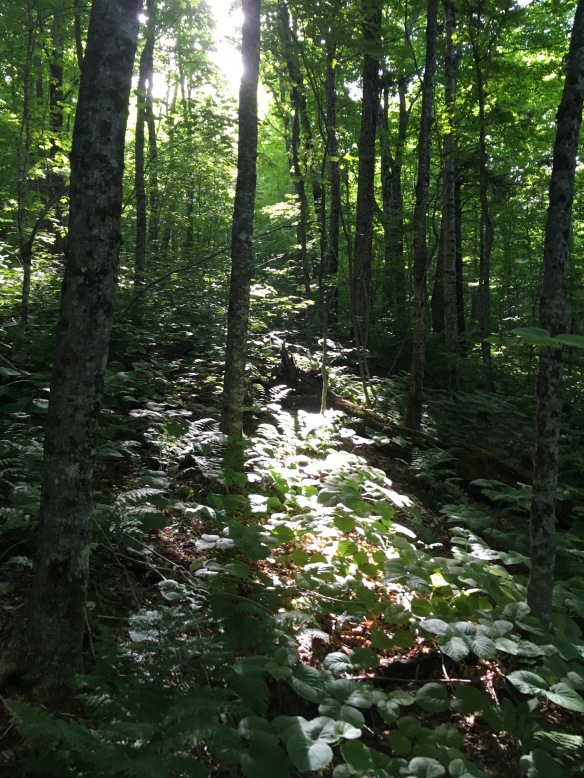
At around 4:30pm I crossed the only other hikers I saw on this section of the Castle Trail, a father and son who were ascending. I wondered about that, as it was getting late!
I continued walking moderately downward, and reached the end of the loop at 5:30pm. Here I passed the turnoff I had taken that morning on the Israel Ridge Path, and continued downward, now not steep at all, to the end of the hike:


At 6pm I reached the stream that was near the parking area, where I had dipped my boots that morning:

And the final warning sign!

And here is a video of my last steps on the Castle Trail, walking to the parking area, after having completed the final ascent of the 48 4000-footers!
That last part of the Castle Trail is along an old railway bed, so is flat and easy. But the day had been anything but flat and easy, as befitting a two-year journey up 48 challenging peaks. It felt great to finish!
I climbed Mt Jefferson again in later years, and in different seasons. For short descriptions of those climbs, click here.
*
Some Final Thanks!
I had a great feeling of accomplishment, a serious sense of achievement at having climbed these 48 majestic and formidable mountains, in just over two years. I was sore and exhausted, but left with deep respect and gratitude for this land and these mountains, for the opportunity I was given to experience them, and to learn from them.
In a similar sense, as I wrap up this “4000-Footer” series, I want to take time to thank some of the people who I was lucky to work with, learn from, across these 35 years. They have been “4000-Footers” in my life, and I am left with a deep sense of respect and gratitude to each of them… and so, in rough chronological order:
As I wrote in the third article in this series, after my first year as a Peace Corps Volunteer, Annuska Heldring arrived in Azogues, opening Plan International’s new Field Office for Cañar. In that earlier blog, I described Annuska (“Doctorita”) as charismatic, dedicated, and hilarious. But that only begins to describe her, and the influence she has had on me and my career since 1985.
After I left Azogues, and the Peace Corps, it was Annuska who introduced me to Plan and who opened the door for me to join that organization. I owe my career to her.
Along the way, I would end up working several times directly with Annuska, even becoming her manager as she worked in Colombia, Paraguay, and Albania. Along the years, her instincts were always right, and I learned a lot from her courage and her ability to sweeten difficult discussions with a dose of good humor.
Thank you Annuska!
I joined the INGO world properly in 1987, when Jean and I moved to Tuluá, Colombia, and I took up the role of Assistant Director for Plan Tuluá. Monique van ‘t Hek was my first boss there, serving brilliantly as Field Director. Plan had an excellent induction program in those days, which helped a lot. But I was also lucky to have been assigned to Tuluá, because Monique was an inspiring leader and very effective manager. Not an easy combination, but she did it well, and made it look easy – it’s not!
I was lucky that Monique was my first INGO manager, because along with strong management and leadership skills, she had a very solid approach to building community ownership of the development process, as masterfully illustrated in her stewardship of the creation of a new community – Barrio Internacional – comprised of poor single mothers who would now have their own homes.
As I’ve mentioned earlier in this blog series, Plan Tuluá was a “pilot” office for Plan’s new directions, and Monique managed the sometimes tricky balancing of our local concerns and realities with the need to respond constructively to Plan’s regional and international priorities. Huge learning for me.
Monique has returned to Plan, this time in the huge job of National Director for the Netherlands. They are lucky to have her!
Thank you Monique!


When we arrived in Tuluá, Monique’s manager was Leticia Escobar, Area Manager for Colombia and Ecuador. Leticia worked from Plan’s new, pilot Regional Office, in Quito, Ecuador. She had served in field positions with Plan in Colombia and Bolivia, and was chosen as part of the first Regional Office team, which was established in 1987.
When I succeeded Monique as Field Director for Plan Tuluá, Leticia became my boss. Later, when I moved to the South America Regional Office (SARO), she was my colleague; and then, as these things go, when I became SARO’s second Regional Director, she worked for me!
I greatly enjoyed working for, and with, Leticia. She was a very kind, thoughtful, hardworking, committed professional, who overcame significant personal challenges to carry out her duties to a very high quality. She kept things simple, never put her own ego or personality into the mix, and didn’t complicate matters – a rare talent.
Thank you Leticia!

SARO’s first Regional Director was Andy Rubi, a person who inspired me, and influences me still, to become the best I could be. Andy had served with Plan in a range of field positions and, when the organization decided to regionalize, and to pilot test a regional structure in South America, the organization chose the best possible person to lead things. So Andy became Plan’s first Regional Director.
It wasn’t an easy task. Regionalization of any large organization, as Plan was becoming, is very complicated and complex, fraught with political behavior and clumsy compromises. To some extent, Plan’s first regionalization was not accompanied by the level of decentralization needed to make things work. That was corrected later, but it is to Andy’s great credit that he navigated these tricky waters with grace, humor, and great success.
When Jean and I went to Tuluá in 1987, Andy had just set up the South America Regional Office, in Quito. He brought me to Quito as Area Manager for Ecuador and Bolivia, three years later, as several of the initial SARO managers moved to help staff the next Regional Office to be established, in Manila. When Andy himself moved to serve as acting International Executive Director at Plan’s headquarters, I was appointed to succeed him as SARO’s second RD.
It would be hard to overstate how much I learned from Andy. Just to note one, of many, lessons: when discussions got heated, Andy would bring us back to our senses with a simple question – “what is the issue?” I often use that approach, and find that it is enormously clarifying.
Even recently, nearly 30 years after I first met Andy, he has helped me with wise counsel in a particularly complicated personnel matter.
Thank you Andy!

When I succeeded Andy as Plan’s second Regional Director for South America, in 1992, I inherited a great team: Leticia Escobar (see above), Hernando Manrique, Luis Alfredo Cevallos, Ivette Lopez, Washington Muñoz, Tony Nolan, Roger Braden, Norma Fierro, Maggie Bastidas, and many others.
Soon Ricardo Gómez would join the South America team as Regional Administrator. We worked together for a couple of years, and during that time Ricardo demonstrated the dedication, and intelligence that characterizes him to this day. Ricardo was transitioning from the private sector (an MBA graduate, he had been working for Exxon/Intercor in Colombia) to where he felt he could contribute and realize himself, in our nonprofit world.
I quickly came to admire Ricardo’s courage. We faced a very challenging, and risky, situation involving a very corrupt senior staff member, and Ricardo faced the situation squarely and with great clarity.
Later Ricardo would move to Colombia as Country Director, and then to Sri Lanka in the same role. Ricardo retired from Plan in Guatemala, where he took a poorly-performing, low-morale Country Office and, through his leadership and courage, molded the operation into an example of effectiveness and team spirit. Today Ricardo has returned to his home country, and serves as HR Director for his family’s business there. But we have remained the closest of friends. We travelled for a month together, in India, a couple of years ago, and will be trekking in Nepal later this year. Here he is enjoying a refreshment in Varanasi during that trip:

Thank you, Ricardo!
When Alberto Neri left Plan, Andy Rubi became acting International Executive Director, the titled used for Plan’s CEO at that time. A new IED was appointed in 1992 – Max van der Schalk joined Plan from a career in Shell Oil.
In an earlier blog in this series I described Max as “Dutch, in his late 50’s, who had just completed a long career at Shell, finishing up as President of Shell Colombia … I found Max to be very easy to get along with. He was a great listener, funny and curious, and very confident in his own skin. Max had just as much business experience as Alberto (something that Plan’s board clearly wanted), but seemed to be a much more accessible, open, and emotionally-intelligent person.”
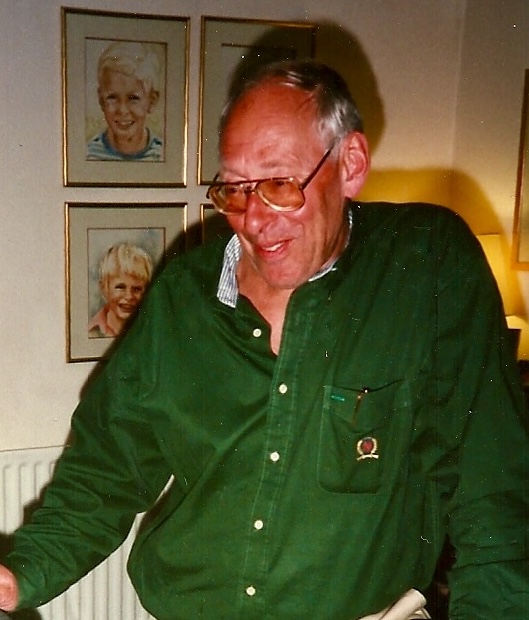
I learned an enormous amount from Max. He managed the organization with great panache, little ego, and clarity. When Max began to think through how to approach his new job, he gave me the opportunity to join him in that journey, and supported me as I designed and implemented the priorities I thought needed to be accomplished at headquarters: new program goals to unite us; clarity on where the organization would invest our resources, and where we would phase out; and what our working organizational structure would be.
Max was kind enough to write a guest blog for this series, which is here. And here is a recent photo, from April 2018, of Max and Annuska, with Jean and me:
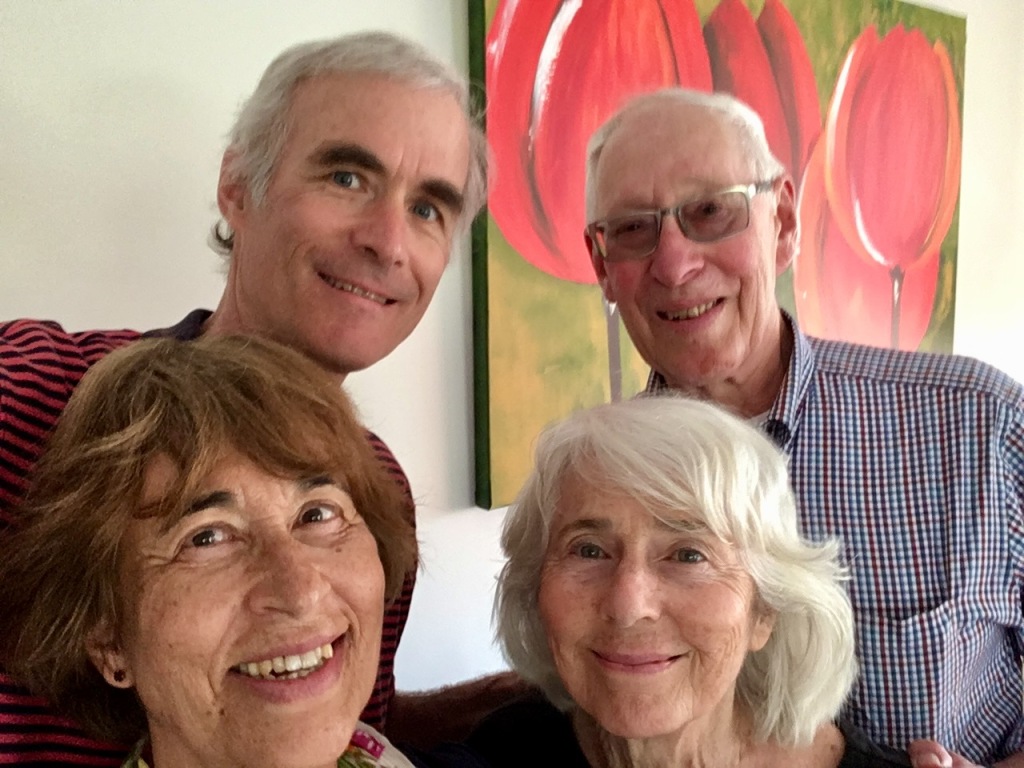
Thank you, Max!
One of Plan’s superstars was Donal Keane. When I served as program director at Plan’s headquarters, under Max van der Schalk, I had asked Donal to participate in the “skunk works” through which we created Plan’s new operational structure. When I formed that group, I had two goals: to create the best possible draft structure, and to shine a light on what I thought would be the next generation of leaders for Plan.
In the first image, Donal is to the right, with another Plan superstar, Catherine Webster. In the second image, Donal is in the center, between Catherine and, I think, Winnie Tay.

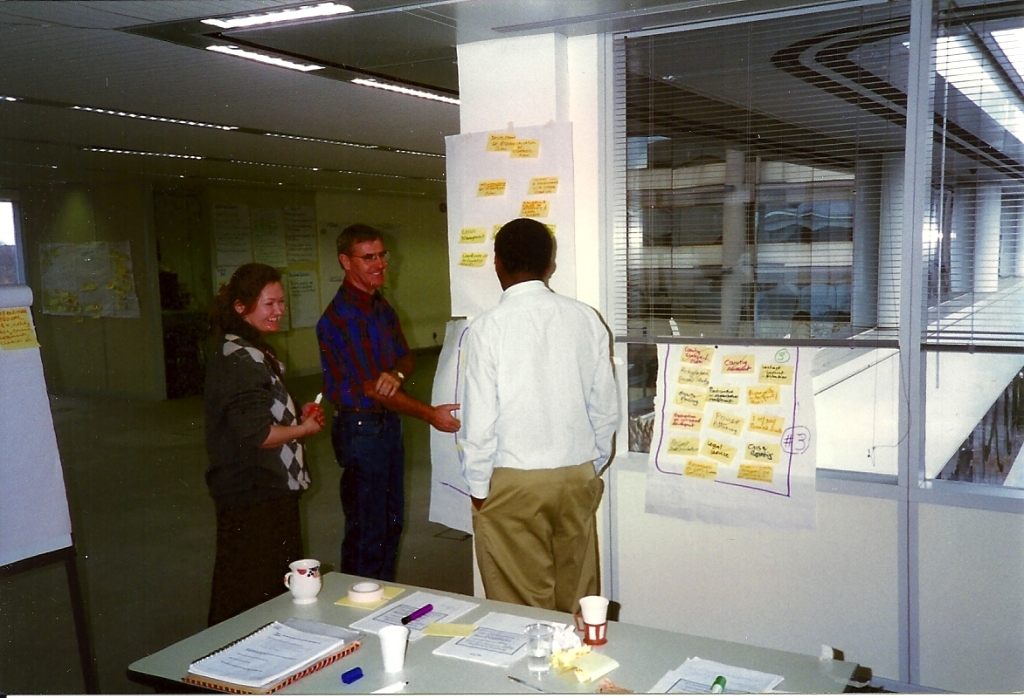
Later, as these things go, Donal became my supervisor when I served as Country Director for Plan in Viet Nam, and Donal was Plan’s Regional Director for Southeast Asia. He was an ideal manager, clear and calm and decisive. He was very supportive when I proposed an outlandish pilot test of a new way of organizing Plan’s work. I learned a lot from Donal, from his approach to managing and leading in the NGO world.
Thank you Donal!
Working at any INGO headquarters is challenging. When Max had asked me to work with him at Plan’s head office, I proposed serving there for three years, just to make the point that hierarchical position shouldn’t be the goal inside our sector – get in, contribute and serve, and go back to the field to “face the mess you created” at headquarters.
So after serving as Plan’s program director, I took a year’s unpaid sabbatical and then was lucky to move to Viet Nam for four years, as Plan’s second Country Director in that country.
Those were amazing years. I was very fortunate to work with a stellar team, which I’ve written about extensively in an earlier article. A great team, great people.
There were many special people on that team, but one person really stands out: Pham Thu Ba, our “Operations Support Manager.” Or, as she often referred to her role, “Miscellaneous Support Manager.”
Here I will quote from my earlier article.
Thu Ba became OSM when she was only 26 years old, and is one of the smartest, hardest-working and most effective professionals I’ve ever worked with – in Plan and beyond. Her dedication to Plan’s work was unrivaled, and her ability to supervise the complex financial, administrative, and operational side of our work was very impressive. Again, I can only imagine the pressures that Thu Ba faced in shepherding our financial and operational work, but she made it look easy.
I often tell an anecdote about Thu Ba, which I think describes what it was like working with these amazing people. At the end of my first year, I carried out the performance reviews of the people who reported to me, including her. Even more than most, Thu Ba’s work that year (and later) had been superb, so I had only positive comments to share with her.
Imagine my surprise when, after finishing providing lots of specific, positive feedback, Thu Ba’s response was:
— “You’re not doing your job.”
Wow, not the response I had expected. She went on to tell me that, as the only foreigner in the office, staff expected me to bring “international standards” to their work, and to guide them towards doing better jobs. So, if I couldn’t help her improve, I wasn’t doing my job! And, helpfully providing feedback to me (!), she described how people in the office were viewing my style:
— “You always start by saying something positive, something we are doing right, or well. Then you sometimes add suggestions for improvement. We don’t listen to the first part, only to the second part, because that’s where we can learn.”
What an amazing response. Since Thu Ba’s work was of such high quality, it wasn’t easy to identify specific areas where improvement was needed, or even possible, but I promised to give her that kind of feedback in the future. I did rise to that challenge, but it wasn’t easy!
That’s one aspect of what it was like working in Viet Nam in those years – the innate intelligence and hard work of the people, combined with the country’s relatively-recent opening to the world, meant that people like me were seen as very important resources that could be learned from. We were automatically looked up to as sources of “international standards.”
Often this status wasn’t really deserved (some of the foreigners I knew in Hanoi couldn’t add much value), and it’s changed now (Vietnamese people I know there now no longer look to foreigners automatically as fountains of wisdom), but I enjoyed it at the time!
My experience leading and managing the great Vietnamese staff in Plan has influenced my style ever since. We American managers take such a nurturing, affirmational approach (for example, we love using tools like “appreciative inquiry”), that we often neglect to indicate where staff can improve. This is what was happening that first year with Thu Ba. And we don’t spend enough time observing our staff. Working in Viet Nam helped me in this regard – I always make sure to complement positive, affirmational feedback with areas where the staff member could improve or develop.
Later, Thu Ba trained in HR management and development at the University of London, and today she manages that side of Plan’s work in Viet Nam, which is a big job. From Australia I would continue to visit Viet Nam several times a year, and was happy to get together with Thu Ba and her husband and two children on most of my visits.
Many thanks to Thu Ba!

After 15 years with Plan, and four great years in Viet Nam, it felt that it was time to lead another life. Plan had been a fantastic, generous place to work, and I would always be grateful to the organization for the opportunities it gave me to serve, to learn, and to realize myself.
But it was time to repot myself…
As I’ve written in an earlier article, a great opportunity presented itself at exactly the right time. As I said in that article: just as I was leaving Hanoi, I got an email from out of the blue, from a person I had never met. Daniel Wordsworth was Program Development Director at CCF in Richmond, Virginia, and he wanted to know if I knew anybody who could help them reinvent their program approach. I thought I knew of the perfect person…
That call led to three incredible years, helping CCF conceptualize, pilot test, and refine a new program approach which we came to call “Bright Futures.” For me, that process was a super example of rigorous, evidence-based, and effective organizational change in a major INGO. So I took the time in this blog series to describe it over five articles: here, here, here, here, and here.
Daniel was, and is, a brilliant and insightful person, the perfect person to partner with. Later he left CCF and is now the CEO of Alight (formerly American Refugee Committee), an INGO working in humanitarian aid and disaster relief. When you look at Alight’s website, you’ll come to appreciate Daniel’s gifts as I do.

Thank you Daniel!
By 2005, we had finished developing Bright Futures, and the next phase beckoned. But what would that be?
At that point, Jean and I had been living back in the United States for three years, having left Hanoi in late 2002. Those years – Bush’s Iraq invasion, his post-9/11 assault on civil liberties and use of torture – were sad ones for my country. It felt urgent to face the situation and apply myself to my own country.
Again, I was very lucky. While I was still consulting with CCF, I noticed a posting for the program director position at a Cambridge-based NGO called the “Unitarian Universalist Service Committee” (“UUSC“). I looked into it, and I really liked what I saw: a human-rights organization, working inside the US and overseas to advance social justice. I decided to apply…
I didn’t get that job, but later the president and CEO of UUSC, Charlie Clements, approached me for another role: Executive Director!
At that point, UUSC had defined its program, focusing on three broad areas: civil liberties, economic justice, and environmental justice. As I wrote in an earlier article, we later added a fourth focus – rights in (humanitarian) crises.
Despite some challenges, it was a perfect place for me – I was able to help UUSC thrive as an organization, while learning from Charlie’s long and deep human-rights and advocacy experience and working on some of the key issues of those years, including a large-scale response to our government’s inept and unjust “response” to Hurricane Katrina in New Orleans.
As I said in that earlier article, Charlie was, and is, a gifted and passionate communicator, who has lived his life in service of human rights. He began his career in the US Air Force, and graduated from the US Air Force Academy. While serving in Viet Nam, Charlie refused to fly missions into Cambodia in support of our illegal invasion of that neutral country, and was discharged. Switching professions, Charlie went back to school to become a medical doctor and then practiced medicine behind rebel lines in El Salvador. That experience resulted in a book and an Academy-Award-winning documentary (1986), both titled “Witness To War.”
Charlie was very generous to give me the opportunity at UUSC. I learned a great deal from him – after 20 years in the international development, poverty-focused sector, I was ready to tackle deeper issues of injustice and oppression. Charlie’s life, lived on the front-lines of social justice, and his deep expertise left big impressions on me and helped me grow.

Thank you Charlie!
In 2009, Jean and I moved to Sydney, Australia, where I took up the newly-created post of International Program Director for ChildFund Australia. (CCF was rebranding to ChildFund, and the Australian member had been one of the first to adopt the new name.)
We spent six years in Australia, where I was very fortunate to work for Nigel Spence, the ChildFund Australia’s CEO. The whole ChildFund Australia team was fantastic – Di Mason, Lynne Joseph, Bandula Gonsalkorale, Jan Jackson, Xavier Hennekinne, Deb Leaver, Carol Mortenson, Prashant Verma, Manish Joshi, Chris Mastaglio, Keo Souvannaphoum, Win May Htwe, Nini Htwe, and so many others.
Nigel stands out, both because he was our leader and manager, but also because of his steady, calm, common-sense approach to our work. He delegated well, supported the people (like me) who worked for him, and kept the organization on a clear and accountable course.


It was a pleasure working for Nigel – he got the best from all of us, and navigated the sometimes nerve-wracking changes that I wanted to put in place (see these five articles: here, here, here, here, and here), tried to put in place, without any noticeable nervous breakdowns! Nearly always calm and clear, Nigel made it possible for us to do our best.
Thank you Nigel!
Most of all, to Jean. We have made this journey our own, together, across the years.

And many thanks to you, dear readers! Thanks for taking the time to read these articles. I hope you’ve enjoyed reading them as much as I’ve loved writing them!
Onward!
*
Here are links to all the posts in this series. There are 48 articles, including this one, each one about climbing one of New Hampshire’s 4000-footers, and also reflecting on a career in international development:
- Mt Tom (1) – A New Journey;
- Mt Field (2) – Potable Water in Ecuador;
- Mt Moosilauke (3) – A Water System for San Rafael (part 1);
- Mt Flume (4) – A Windmill for San Rafael (part 2);
- Mt Liberty (5) – Onward to Colombia, Plan International in Tuluá;
- Mt Osceola (6) – Three Years in Tuluá;
- East Osceola (7) – Potable Water for Cienegueta;
- Mt Passaconaway (8) – The South America Regional Office;
- Mt Whiteface (9) – Empowerment!;
- North Tripyramid (10) – Total Quality Management for Plan International;
- Middle Tripyramid (11) – To International Headquarters!;
- North Kinsman (12) – Fighting Fragmentation and Building Unity: New Program Goals and Principles for Plan International;
- South Kinsman (13) – A Growth Plan for Plan International;
- Mt Carrigain (14) – Restructuring Plan International;
- Mt Eisenhower (15) – A Guest Blog: Max van der Schalk Reflects on 5 Years at Plan’s International Headquarters;
- Mt Pierce (16) – Four Years At Plan’s International Headquarters;
- Mt Hancock (17) – Hanoi, 1998;
- South Hancock (18) – Plan’s Team in Viet Nam (1998-2002);
- Wildcat “D” Peak (19) – Plan’s Work in Viet Nam;
- Wildcat Mountain (20) – The Large Grants Implementation Unit in Viet Nam;
- Middle Carter (21) – Things Had Changed;
- South Carter (22) – CCF’s Organizational Capacity Assessment and Child Poverty Study;
- Mt Tecumseh (23) – Researching CCF’s New Program Approach;
- Mt Jackson (24) – The Bright Futures Program Approach;
- Mt Isolation (25) – Pilot Testing Bright Futures;
- Mt Lincoln (26) – Change, Strategy and Culture: Bright Futures 101;
- Mt Lafayette (27) – Collective Action for Human Rights;
- Mt Willey (28) – Navigating Principle and Pragmatism, Working With UUSC’s Bargaining Unit;
- Cannon Mountain (29) – UUSC Just Democracy;
- Carter Dome (30) – A (Failed) Merger In the INGO Sector (1997);
- Galehead Mountain (31) – What We Think About When We Think About A Great INGO Program;
- Mt Garfield (32) – Building Strong INGO Teams: Clarity, Trust, Inspiration;
- Mt Moriah (33) – Putting It All Together (Part 1): the ChildFund Australia International Program Team;
- Owls’ Head (34) – Putting It All Together (Part 2): ChildFund Australia’s Theory of Change;
- Bondcliff (35) – ChildFund Australia’s Development Effectiveness System;
- West Bond (36) – “Case Studies” in ChildFund Australia’s Development Effectiveness System;
- Mt Bond (37) – Impact Assessment in ChildFund Australia’s Development Effectiveness System;
- Mt Waumbek (38) – “Building the Power of Poor People and Poor Children…”
- Mt Cabot (39) – ChildFund Australia’s Teams In Cambodia, Laos, Myanmar, Papua New Guinea, and Viet Nam;
- North Twin (40) – Value for Money;
- South Twin (41) – Disaster Risk Reduction;
- Mt Hale (42) – A “Golden Age” for INGOs Has Passed. What Next?;
- Zealand Mountain (43) – Conflict: Five Key Insights;
- Mt Washington (44) – Understanding Conflicts;
- Mt Monroe (45) – Culture, Conflict;
- Mt Madison (46) – A Case Study Of Culture And Conflict;
- Mt Adams (47) – As I Near the End of This Journey;
- Mt Jefferson (48) – A Journey Ends…

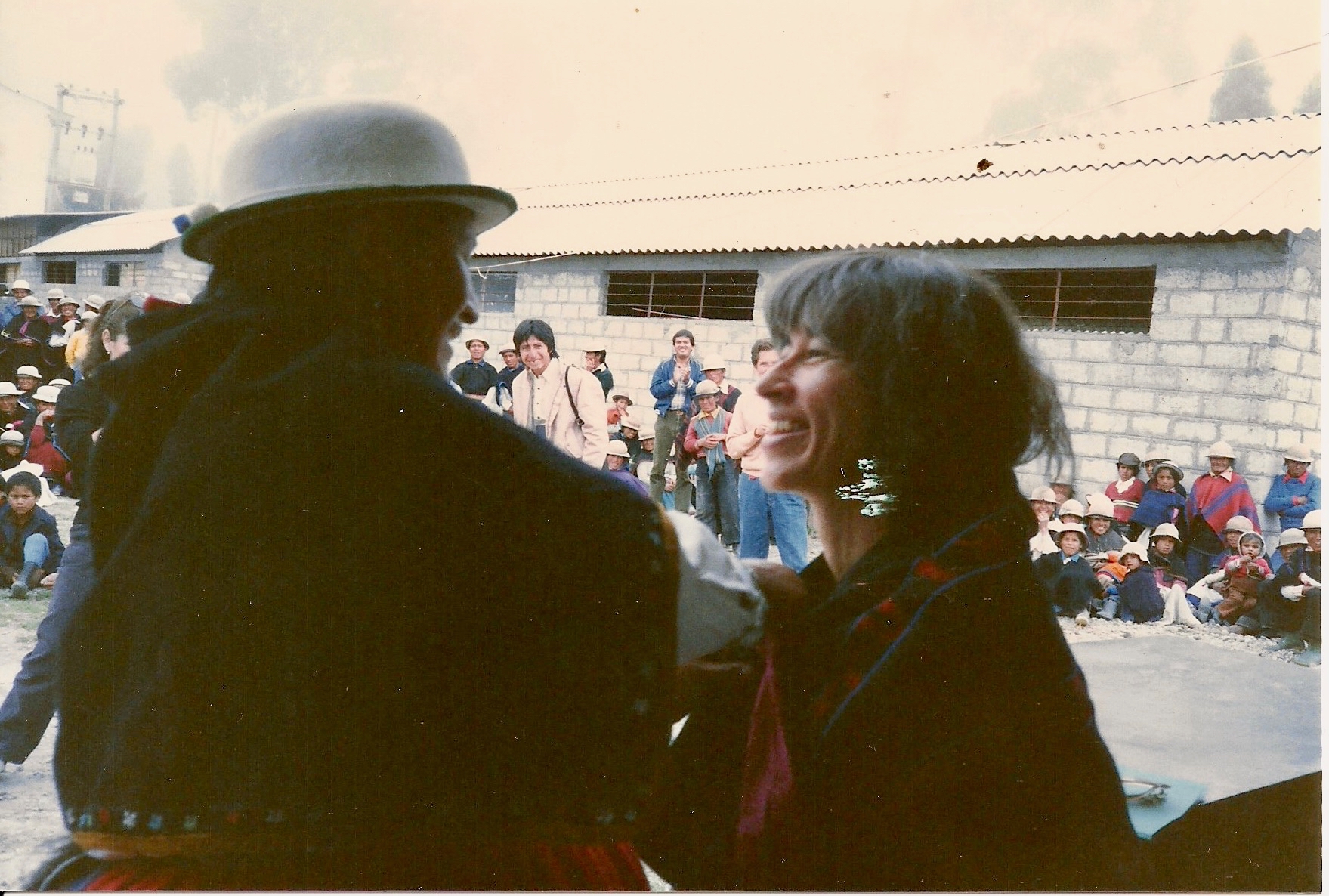
It has been wonderful to read about all the journeys and the journeys within the journeys. I will be looking for what’s next!
Pingback: Mt Adams (47) – As I Near the End of This Journey. | Mark McPeak
“Moose” River? You’re kidding, right?
Well, moose droppings—yah, I can see that, though maybe it’s a baby moose.
Pingback: Mt Tom (1) – A New Journey | Mark McPeak
Pingback: Mt Field (2) – Potable Water in Ecuador | Mark McPeak
Pingback: Mt Moosilauke (3) – A Water System for San Rafael (part 1) | Mark McPeak
Pingback: Mt Liberty (5) – Onward to Colombia, Plan International in Tuluá | Mark McPeak
Anh Mark ơi,
Congratulations for your accomplishment. It is worth to follow your steps in this meaningful and rewarding journey. It has been 20 years since you left Vietnam, but all, I believe, including me still miss you so much. We have learned a lot from you and keep applying a part (some parts have been more challenging for us) of what we have learned for our journeys either at development or business sectors. It is time for me to count days to have a chance for your reunion with the team in Vietnam.
Keep moving forward with a more joyful journey. We are still with you, anh Mark 🙂
Warm regards from super hot Hanoi.
Thanks very much for your comment, Thu Ba. It’s been fun writing all these article, and climbing all those mountains. Looking forward to seeing you, and the team, soon in Hanoi!
Pingback: Mt Flume (4) – A Windmill for San Rafael (part 2) | Mark McPeak
Many thanks for sharing your many valuable insights, Mark. Reading your 48 blogs has been like throwback time plus free servings of additional learning thanks to the many points that allowed me to reflect on the development and professionalization processes of NGOs. The articles have also offered a more complete understanding of many key events in Plan.
On other occasions, your points shed new light, or confirmed my own thinking. Such as about the role and relevance of the big agencies. Can they remain relevant while the traditional North – South divide is getting more and more opaque, sponsors’ spans of attention and feelings of urgency becoming even shorter, and the climate crisis overwhelming us all? My most recent visits to the Field have left me worried.
And finally, it was great so see the photos and read the names again of so many great ‘Planners’, including: Monique, Annuska, Max, Andy, Donal, Supriyanto, Minh Thu, Thu Ba, Thuy, Ricardo, Roger, Paul, Ron Seligman, Rezene, Raymond, Tim, Richard Thwaites, Mac Abbey, Martin and, of course yourself.
Stay well, Mark!
Thanks very much, Chris! So glad to hear that you made it through all 48, it must have been like climbing all those mountains! Take care…
Pingback: Mt Madison (46) – A Case Study of Culture and Conflict | Mark McPeak
Pingback: Mt Osceola (6) – Three Years in Tuluá | Mark McPeak
Pingback: East Osceola (7) – Potable Water for Cienegueta | Mark McPeak
Pingback: Mt Passaconaway (8) – The South American Regional Office (SARO) | Mark McPeak
Pingback: Mt Whiteface (9) – Empowerment! | Mark McPeak
Pingback: North Tripyramid (10) – Total Quality Management for Plan International | Mark McPeak
Pingback: Mt Eisenhower (15) – A Guest Blog: Max van der Schalk Reflects on 5 Years at Plan’s International Headquarters | Mark McPeak
Pingback: Middle Tripyramid (11) – To International Headquarters! | Mark McPeak
Pingback: North Kinsman (12) – Fighting Fragmentation and Building Unity: New Program Goals and Principles for Plan International | Mark McPeak
Thank you for sharing your insights from a long journey. It’s is really impressive and helpful with us. I appreciate your aim along all the blogs in this series, and many people must have to say thank you for what you’ve made uniquely for all of us.
Thanks, Mai! I’m happy that you read through these long articles, I certainly enjoyed writing them! Take care, and looking forward to seeing you in December in Hanoi…
Hi Mark,
I am looking forward to receiving you in Hanoi and my family will meet you then. Surprisingly you had been in UNSW where my daughter have studied and is working there.
Pingback: Cross-Culture Communication – Chaos Narrowly Averted! | Mark McPeak
Pingback: Mt Isolation (25) – Pilot-Testing Bright Futures | Mark McPeak
Pingback: Mt Tecumseh (23) – Researching CCF’s New Program Approach | Mark McPeak
Pingback: Mt Jackson (24) – The Bright Futures Program Approach | Mark McPeak
Pingback: Mt Washington (44) – Understanding Conflicts | Mark McPeak
Pingback: Mt Hale (42) – A “Golden Age” for INGOs Has Passed. What Next? | Mark McPeak
Pingback: South Twin (41) – Disaster Risk Reduction | Mark McPeak
Pingback: North Twin (40) – Value for Money | Mark McPeak
Pingback: South Kinsman (13) – A Growth Plan for Plan International | Mark McPeak
Pingback: Mt Carrigain (14) – Restructuring Plan International | Mark McPeak
Pingback: Mt Pierce (16) – Four Years At Plan’s International Headquarters | Mark McPeak
Pingback: Mt Hancock (17) – Hanoi, 1998 | Mark McPeak
Pingback: Wildcat “D” Peak (19) – Plan’s Work in Viet Nam | Mark McPeak
Pingback: Wildcat Mountain (20) – The Large Grants Implementation Unit in Viet Nam | Mark McPeak
Pingback: Middle Carter (21) – Things Had Changed | Mark McPeak
Pingback: South Carter (22) – CCF’s Organizational Capacity Assessment and Child Poverty Study | Mark McPeak
Pingback: Mt Lincoln (26) – Change, Strategy and Culture: Bright Futures 101. | Mark McPeak
Pingback: Mt Lafayette (27) – Collective Action for Human Rights | Mark McPeak
Pingback: Mt Willey (28) – Navigating Principle And Pragmatism, Working With UUSC’s Bargaining Unit | Mark McPeak
Pingback: Carter Dome (30) – A (Failed) Merger In the INGO Sector (1997) | Mark McPeak
Pingback: Galehead Mountain (31) – What We Think About When We Think About A Great INGO Program | Mark McPeak
Pingback: Mt Garfield (32) – Building Strong INGO Teams: Clarity, Trust, Inspiration | Mark McPeak
Pingback: Mt Moriah (33) – Putting It All Together (Part 1): the ChildFund Australia International Program Team | Mark McPeak
Pingback: Owl’s Head (34) – Putting It All Together (Part 2): ChildFund Australia’s Theory of Change | Mark McPeak
Pingback: Bondcliff (35) – ChildFund Australia’s Development Effectiveness Framework | Mark McPeak
Pingback: Mt Bond (36) – “Case Studies” In ChildFund Australia’s Development Effectiveness Framework | Mark McPeak
Pingback: Mt Waumbek (38) – “Building the Power of Poor People and Poor Children…” | Mark McPeak
Pingback: South Hancock (18) – Plan’s Team in Viet Nam (1998-2002) | Mark McPeak
Pingback: Mt Monroe (45) – Culture, Conflict | Mark McPeak
Pingback: Everest Base Camp Trek – Part 1 | Mark McPeak
Pingback: Zealand Mountain (43) – Conflict: Five Key Insights | Mark McPeak
Pingback: West Bond (37) – Impact Assessment in ChildFund Australia’s Development Effectiveness Framework | Mark McPeak
Pingback: Climbing Mt Tom Again | Mark McPeak
Pingback: Climbing Mt Moosilauke Again | Mark McPeak
Pingback: Climbing Mt Carrigain Again | Mark McPeak
Pingback: Climbing Mt Moriah Again | Mark McPeak
Pingback: Climbing Mt Flume Again | Mark McPeak
Pingback: Climbing Mt Liberty Again | Mark McPeak
Pingback: Climbing Mt Osceola Again | Mark McPeak
Pingback: Climbing Mt Adams Again | Mark McPeak
Pingback: Climbing East Osceola Again | Mark McPeak
Pingback: Climbing Mt Field Again | Mark McPeak
Pingback: Climbing South Carter Again | Mark McPeak
Pingback: Climbing Middle Carter Again | Mark McPeak
Pingback: Climbing Mt Monroe Again | Mark McPeak
Pingback: Climbing Mt Eisenhower Again | Mark McPeak
Pingback: Climbing Mt Passaconaway Again | Mark McPeak
Pingback: Climbing Mt Whiteface Again | Mark McPeak
Pingback: Climbing North Tripyramid Again | Mark McPeak
Pingback: Climbing Carter Dome Again | Mark McPeak
Pingback: Climbing Mt Hale Again | Mark McPeak
Pingback: Climbing Zealand Mountain Again | Mark McPeak
Pingback: Climbing Mt Jefferson Again | Mark McPeak
Pingback: Climbing Mt Jackson Again | Mark McPeak
Pingback: North Kinsman #3 – 21 December 2023 | Mark McPeak
Pingback: Mt Waumbek #2 – 5 January 2024 | Mark McPeak
Pingback: Mt Moosilauke #2 – 5 August 2018 | Mark McPeak
Pingback: East Osceola and Mt Osceola #3 – 21 November 2022 | Mark McPeak
Pingback: Mt Hancock (#3) & South Hancock (#4) – 5 February 2024 | Mark McPeak
Pingback: Mt Tecumseh #3 – 15 February 2024 | Mark McPeak
Pingback: Mt Jackson #3, Mt Pierce #4, Mt Webster #2 – 1 September 2023 | Mark McPeak
Pingback: Mt Jackson #2, Mt Webster #1 – 18 November 2020 | Mark McPeak
Pingback: Mt Carrigain #2 – 22 June 2019 | Mark McPeak
Pingback: Mt Carrigain #3 – 29 March 2023 | Mark McPeak
Pingback: South Kinsman #3, North Kinsman #4 – 17 April 2024 | Mark McPeak
Pingback: Mt Madison #3 – 23 April 2024 | Mark McPeak
Pingback: Mt Adams #2 & Madison #2 – 30 August 2019 | Mark McPeak
Pingback: Mt Adams #3 – 8 May 2023 | Mark McPeak